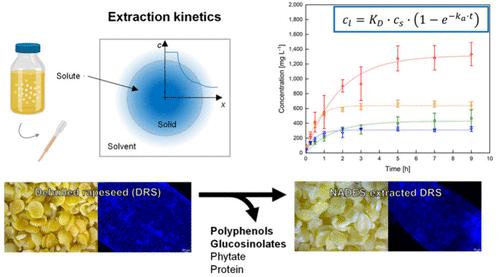精制油菜籽:用天然深共晶溶剂从整个去皮油菜籽中提取多酚、硫代葡萄糖苷、植酸盐和蛋白质
IF 7.3
1区 化学
Q1 CHEMISTRY, MULTIDISCIPLINARY
引用次数: 0
摘要
天然深共晶溶剂(NADES)已被证明具有从植物材料中提取酚类化合物的优异性能。在这项研究中,我们研究了氯化胆碱和甜菜碱-1,2-丙二醇为基础的NADES从整个去皮油菜籽中提取酚类化合物、硫代葡萄糖苷、植酸盐和蛋白质的动力学和效率。将这些NADES与1,2-丙二醇、水和60%的水乙醇进行比较。保持溶剂温度(55℃)和料液比(1:10 w/w)不变。在NADES和1,2-丙二醇中,随着水含量的增加,酚类化合物和硫代葡萄糖苷的提取率常数在10 ~ 40% w/w范围内增加了10倍以上。氯胆碱基NADES提取总酚类化合物最多,达6.79 g kg-1,甜菜碱基NADES提取硫代葡萄糖苷最多,达3.48 g kg-1。植酸盐的溶解度随着NADES和1,2-丙二醇含水量的增加而增加。蛋白质的提取也随着水含量的增加而增加,但其动力学比酚类化合物的提取慢。限制溶剂含水量和萃取时间将有助于利用分析物之间的萃取动力学差异,确保低蛋白质共萃取。提取的油菜籽可进一步加工,回收纯化的、白色的、口感普通的油籽体、油菜籽蛋白和纤维。本文章由计算机程序翻译,如有差异,请以英文原文为准。

Rapeseed Refined: Extraction of Polyphenols, Glucosinolates, Phytate, and Protein from Whole Dehulled Rapeseed Using Natural Deep Eutectic Solvents
Natural deep eutectic solvents (NADES) have been shown to provide excellent extraction capabilities for phenolic compounds from plant materials. In this study, we investigated the kinetics and efficiency of choline chloride- and betaine-1,2-propanediol-based NADES to extract phenolic compounds, glucosinolates, phytate, and proteins from whole dehulled rapeseed kernels. These NADES were compared to 1,2-propanediol, water, and 60% aqueous ethanol. Solvent temperature (55 °C) and solid-to-liquid ratio (1:10 w/w) were kept constant. The extraction rate constant for phenolic compounds and glucosinolates increased more than ten times with increasing water content in the range of 10–40% w/w in NADES or 1,2-propanediol. Choline chloride-based NADES extracted the highest amounts of total phenolic compounds, up to 6.79 g kg–1, while betaine-based NADES extracted the highest amounts of glucosinolates, up to 3.48 g kg–1. Phytate solubility increased with increasing water content in NADES and 1,2-propanediol. Protein extraction also increased with an increasing water content but followed slower kinetics than the extraction of phenolic compounds. Limiting solvent water content and extraction duration will help exploit differences between the analytes’ extraction kinetics, ensuring low protein coextraction. The extracted rapeseed could be further processed to recover purified, white, and plain-tasting oleosomes, rapeseed protein, and fiber.
求助全文
通过发布文献求助,成功后即可免费获取论文全文。
去求助
来源期刊

ACS Sustainable Chemistry & Engineering
CHEMISTRY, MULTIDISCIPLINARY-ENGINEERING, CHEMICAL
CiteScore
13.80
自引率
4.80%
发文量
1470
审稿时长
1.7 months
期刊介绍:
ACS Sustainable Chemistry & Engineering is a prestigious weekly peer-reviewed scientific journal published by the American Chemical Society. Dedicated to advancing the principles of green chemistry and green engineering, it covers a wide array of research topics including green chemistry, green engineering, biomass, alternative energy, and life cycle assessment.
The journal welcomes submissions in various formats, including Letters, Articles, Features, and Perspectives (Reviews), that address the challenges of sustainability in the chemical enterprise and contribute to the advancement of sustainable practices. Join us in shaping the future of sustainable chemistry and engineering.
 求助内容:
求助内容: 应助结果提醒方式:
应助结果提醒方式:


